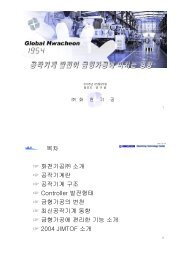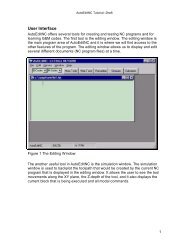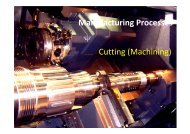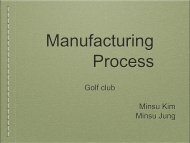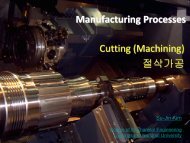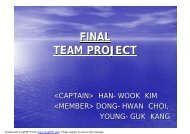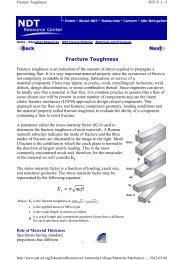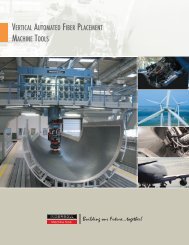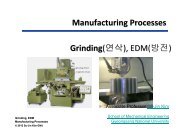Casting
Casting
Casting
Create successful ePaper yourself
Turn your PDF publications into a flip-book with our unique Google optimized e-Paper software.
<strong>Casting</strong><br />
Manufacturing Processes<br />
© 2011 Su-Jin Kim GNU<br />
Manufacturing Processes<br />
<strong>Casting</strong><br />
Associate Professor Su-Jin Kim<br />
School of Mechanical Engineering<br />
Gyeongsang National University
Outline<br />
1. <strong>Casting</strong> Physics<br />
2. Sand <strong>Casting</strong><br />
3. Investment <strong>Casting</strong><br />
4. Die <strong>Casting</strong><br />
5. Cost/Quality<br />
<strong>Casting</strong><br />
Manufacturing Processes<br />
© 2011 Su-Jin Kim GNU
<strong>Casting</strong><br />
• <strong>Casting</strong> is a manufacturing process by which a liquid<br />
material is poured into a mold, which contains a hollow<br />
cavity of the desired shape, and then allowed to solidify.<br />
• First casting: 4000 B.C.<br />
• Bronze, iron age, light metal age?<br />
http://www.youtube.com/watch?v=yXVLbzI3xTE Engine block 5min<br />
<strong>Casting</strong><br />
Manufacturing Processes<br />
© 2011 Su-Jin Kim GNU
<strong>Casting</strong><br />
<strong>Casting</strong> is Versatile<br />
• Many types of metals<br />
• Rapid production<br />
• Wide range of shapes and sizes<br />
• Complex parts as an integral unit<br />
Disadvantage<br />
• Poor dimensional accuracy and surface quality<br />
<strong>Casting</strong><br />
Manufacturing Processes<br />
http://www.youtube.com/watch?v=mx1qteRUYwI Sand, Investment, Lost form SME 6:16<br />
© 2011 Su-Jin Kim GNU
Fluid flow of mold filling<br />
Gravity casting: pouring cup→sprue →well →runner →riser<br />
→ cavity →open riser<br />
Bernoulli’s equation<br />
p<br />
h <br />
g<br />
Velocity of the molten metal leaving the gate<br />
<strong>Casting</strong><br />
Manufacturing Processes<br />
© 2011 Su-Jin Kim GNU<br />
2<br />
v<br />
Constant<br />
2g<br />
h = elevation<br />
p = pressure at elevation<br />
v = velocity of the liquid<br />
ρ = density of the fluid<br />
v <br />
c 2gh
Fluid flow of mold filling<br />
• Reynolds number, Re<br />
Re <br />
• Ordinary gating system: Re = 2,000 ~ 20,000 mixture of<br />
laminar and turbulent flow<br />
<strong>Casting</strong><br />
Manufacturing Processes<br />
© 2011 Su-Jin Kim GNU<br />
vD<br />
<br />
v = velocity of the liquid<br />
D = diameter of the channel<br />
ρ = density<br />
n = viscosity of the liquid.
Heat transfer<br />
• Heat flow depends on casting material and the mold<br />
and process parameters.<br />
• Temperature distribution in the mold-liquid metal<br />
interface is shown below.<br />
<strong>Casting</strong><br />
Manufacturing Processes<br />
© 2011 Su-Jin Kim GNU
Solidification time<br />
• Solidification time is a function of the volume of a<br />
casting and surface area (Chvorinov’s rule).<br />
• Effects of mold geometry and elapsed time on skin<br />
thickness and its shape are show.<br />
<strong>Casting</strong><br />
Manufacturing Processes<br />
© 2011 Su-Jin Kim GNU<br />
Volume <br />
Solidifica tion time C <br />
Surface Area <br />
n<br />
C = constant<br />
n = 2 if Sand casting<br />
n = 1 if Die casting
Shrinkage<br />
• Shrinkage in casting causes dimensional changes and<br />
sometimes cracking<br />
<strong>Casting</strong><br />
Manufacturing Processes<br />
© 2011 Su-Jin Kim GNU
Expendable Mold <strong>Casting</strong> Processes<br />
1. Sand casting<br />
2. Shell mold casting<br />
3. Plaster mold casting<br />
4. Investment casting (lost wax casting)<br />
5. Lost foam casting<br />
<strong>Casting</strong><br />
Manufacturing Processes<br />
© 2011 Su-Jin Kim GNU
Sand casting<br />
• Use expendable sand molds<br />
• Low cost<br />
• Small quantity production<br />
• Complex entire parts at one time<br />
• Low production rate(1–20 pieces/hour-mold)<br />
• Green (moist) sand has almost no part weight limit<br />
• Dry sand has a part mass limit of 2,500 kg<br />
• The sand is bonded together using clays, chemical<br />
binders, or oils.<br />
<strong>Casting</strong><br />
Manufacturing Processes<br />
© 2011 Su-Jin Kim GNU
Sand casting<br />
<strong>Casting</strong><br />
Manufacturing Processes<br />
© 2011 Su-Jin Kim GNU
Sand casting<br />
<strong>Casting</strong><br />
Manufacturing Processes<br />
© 2011 Su-Jin Kim GNU<br />
http://www.youtube.com/watch?v=rgL2Jn5mk1A
Shell mold casting<br />
• Fine sand mixed with a resin is heated by the pattern<br />
and hardened into a shell around the pattern<br />
• Can produce castings with close dimensional tolerances,<br />
good surface finish and low cost.<br />
<strong>Casting</strong><br />
Manufacturing Processes<br />
© 2011 Su-Jin Kim GNU
Plaster(석고) mold casting<br />
• Plaster is mixed with water and poured over the pattern.<br />
• Accurate, good surface and low melting point alloy<br />
<strong>Casting</strong><br />
Manufacturing Processes<br />
http://www.youtube.com/watch?v=xPSI1wUOBnk&p=9B6D9EAE75875D9D<br />
© 2011 Su-Jin Kim GNU
Investment casting<br />
(lost wax casting)<br />
• A wax pattern is coated by ceramic slurry that hardens<br />
into the mold.<br />
• One pattern creates one part, which increases<br />
production time and labor costs.<br />
• Complex geometries, good surface and high melting<br />
point alloy.<br />
<strong>Casting</strong><br />
Manufacturing Processes<br />
© 2011 Su-Jin Kim GNU<br />
SME: http://www.youtube.com/watch?v=PIneaDTZ16g
Investment casting<br />
(lost wax casting)<br />
• Wax pattern Mold Pouring<br />
<strong>Casting</strong><br />
Manufacturing Processes<br />
Coin: http://www.youtube.com/watch?v=4Yvm6fUXf1U<br />
Aerospace: http://www.youtube.com/watch?v=f7FXtnXVqzY<br />
© 2011 Su-Jin Kim GNU
Lost foam casting<br />
• Pattern is made of polystyrene form which evaporates<br />
with molten metal to form a cavity for the casting.<br />
<strong>Casting</strong><br />
Manufacturing Processes<br />
© 2011 Su-Jin Kim GNU
Non-expendable Mold <strong>Casting</strong><br />
Process<br />
1. Permanent-mold casting<br />
2. Die casting<br />
3. Centrifugal casting<br />
4. Continuous casting<br />
<strong>Casting</strong><br />
Manufacturing Processes<br />
© 2011 Su-Jin Kim GNU
Permanent mold casting<br />
• The molten metal is poured into a metal mold.<br />
<strong>Casting</strong><br />
Manufacturing Processes<br />
© 2011 Su-Jin Kim GNU
Die casting<br />
The molten metal is forced into<br />
the die cavity by high pressure.<br />
<strong>Casting</strong><br />
Manufacturing Processes<br />
© 2011 Su-Jin Kim GNU<br />
http://www.youtube.com/watch?v=1AgDGLNE6Es SME 90s
Die casting<br />
• Can be automated for large production runs.<br />
• Strength-to-weight ratio of die-cast parts increases with<br />
decreasing wall thickness.<br />
• Good surface finish and dimensional accuracy.<br />
• It is used for aluminium, magnesium and copper alloys.<br />
<strong>Casting</strong><br />
Manufacturing Processes<br />
© 2011 Su-Jin Kim GNU
Centrifugal casting<br />
• Molten metal is solidify in rotating mold.<br />
• It uses centrifugal force to form cylindrical parts.<br />
<strong>Casting</strong><br />
Manufacturing Processes<br />
© 2011 Su-Jin Kim GNU<br />
Centrifugal force = mv 2 /r<br />
Gravitational force = mg<br />
http://www.youtube.com/watch?v=SUtAamMr4Vs
Continuous casting<br />
• Developed for casting metal slab or strip continuously at<br />
low cost.<br />
<strong>Casting</strong><br />
Manufacturing Processes<br />
© 2011 Su-Jin Kim GNU<br />
Continuous casting<br />
slab<br />
strip<br />
Strip casting<br />
hot rolling<br />
http://www.posco.com/homepage/docs/eng/html/company/product/s91c5010010c.html
<strong>Casting</strong> process comparison<br />
Process Advantages Disadvantages<br />
Sand <strong>Casting</strong><br />
Plaster Cast<br />
Investment Cast<br />
Die <strong>Casting</strong><br />
<strong>Casting</strong><br />
Manufacturing Processes<br />
© 2011 Su-Jin Kim GNU<br />
Almost any metal is cast; Small to<br />
large parts; Low tooling cost<br />
Good dimensional accuracy and<br />
surface finish ; Fine details including<br />
thinner walls; Large parts cost less to<br />
cast than by Investment process<br />
Good dimensional accuracy and<br />
surface finish; Complex shape, fine<br />
detail; Ferrous and non-ferrous<br />
metals<br />
Excellent dimensional tolerances and<br />
surface finish; Parts require a minimal<br />
post machining; High production rate<br />
Low dimensional accuracy &<br />
surface quality<br />
More costly than Sand or<br />
Permanent Mold-<strong>Casting</strong><br />
Limited to nonferrous metals<br />
Costs are higher than Sand,<br />
Permanent Mold or Plaster<br />
process <strong>Casting</strong>s<br />
High die cost; Part size limited;<br />
Limited to nonferrous metals
Design for <strong>Casting</strong><br />
• Corner X<br />
• Uniform section<br />
• Draft direction<br />
<strong>Casting</strong><br />
Manufacturing Processes<br />
© 2011 Su-Jin Kim GNU
Cost of casting<br />
Sand casting<br />
• Tooling and equipment costs are low<br />
• Direct labor costs are high<br />
• Material utilization is low<br />
• Finishing costs can be high<br />
Investment casting<br />
• Tooling costs are moderate depending on the complexity<br />
• Equipment costs are low<br />
• Direct labor costs are high<br />
• Material costs are low<br />
Die casting<br />
• Tooling and equipment costs are high<br />
• Direct labor costs are low to moderate<br />
• Material utilization is high<br />
<strong>Casting</strong><br />
Manufacturing Processes<br />
© 2011 Su-Jin Kim GNU
Quality of <strong>Casting</strong><br />
Sand casting<br />
• Tolerance (0.7~2 mm) and defects are affected by shrinkage<br />
• Material property is inherently poor<br />
• Generally have a rough grainy surface<br />
Investment casting<br />
• Tolerance (0.08~0.2 mm)<br />
• Mechanical property and microstructure depends on the method<br />
• Good to excellent surface detail possible due to fine slurry<br />
Die casting<br />
• Tolerance (0.02~0.6 mm)<br />
• Good mechanical property and microstructure due to high pressure<br />
• Excellent surface detail<br />
<strong>Casting</strong><br />
Manufacturing Processes<br />
© 2011 Su-Jin Kim GNU
Rate of <strong>Casting</strong><br />
Sand casting<br />
• Development time is 2~10 weeks<br />
• Production rate is depending on the cooling time : t~(V/A) 2<br />
Investment casting<br />
• Development time is 5~16 weeks depending on the complexity<br />
• Production rate is depending on the cooling time : t~(V/A) 2<br />
Die casting<br />
• Development time is 12~20 weeks<br />
• Production rate is depending on the cooling time : t~(V/A) 1<br />
<strong>Casting</strong><br />
Manufacturing Processes<br />
© 2011 Su-Jin Kim GNU
Economics of <strong>Casting</strong><br />
• Cost of equipment per casting decreases as number of<br />
parts cast increases.<br />
• When demand is small cost per casting increases, more<br />
economical to manufacture.<br />
<strong>Casting</strong><br />
Manufacturing Processes<br />
© 2011 Su-Jin Kim GNU
References<br />
• POSCO: http://www.posco.com<br />
• http://www.dhcasting.co.kr<br />
• http://www.edaehan.co.kr<br />
• http://www.taechangpi.co.kr<br />
• http://www.donglimms.co.kr<br />
• http://www.yeonghwa.co.kr<br />
• http://www.himet.co.kr<br />
• <strong>Casting</strong>: http://www.custompartnet.com<br />
<strong>Casting</strong><br />
Manufacturing Processes<br />
© 2011 Su-Jin Kim GNU
Solidification of metals<br />
• Pure metals have defined melting points and<br />
solidification takes place at a constant temperature.<br />
• Alloys solidify over a range of temperatures.<br />
<strong>Casting</strong><br />
Manufacturing Processes<br />
© 2011 Su-Jin Kim GNU
Phase diagrams<br />
• A phase diagram or equilibrium diagram shows the<br />
relationships among temperature, composition and<br />
phases present in an alloy system.<br />
<strong>Casting</strong><br />
Manufacturing Processes<br />
© 2011 Su-Jin Kim GNU
The iron-carbon system<br />
• Iron-carbon binary system is represented by the ironiron<br />
carbide phase diagram.<br />
• Ferrite, Austenite, Cementite<br />
<strong>Casting</strong><br />
Manufacturing Processes<br />
© 2011 Su-Jin Kim GNU
Microstructure<br />
• Metals solidified in square mold<br />
a) Pure metals: equiaxed grain on skin, columner grain<br />
solidified in a square mold.<br />
b) Solid-solution alloys: equiaxed grain inner zone<br />
c) Heterogeious nucleation of grains<br />
<strong>Casting</strong><br />
Manufacturing Processes<br />
© 2011 Su-Jin Kim GNU
Microstructure<br />
• When alloy cooled slowly dendrite develops.<br />
• Three basic types of cast structures.<br />
<strong>Casting</strong><br />
Manufacturing Processes<br />
© 2011 Su-Jin Kim GNU<br />
Columnar dendritic Equiaxed dendritic Equiaxed nondendritic
Ceramic-mold casting<br />
• A ceramic slurry is poured over the wooden pattern.<br />
• After hardening, The ceramic mold is removed, dried,<br />
and baked in an oven.<br />
• Ceramic mold is suitable for casting high melting point<br />
metals like as steels.<br />
Wooden pattern<br />
<strong>Casting</strong><br />
Manufacturing Processes<br />
© 2011 Su-Jin Kim GNU<br />
Ceramic mold<br />
Mold is baked
Vacuum casting<br />
• Alternative to investment, shell-mold and green-sand<br />
casting.<br />
• Can be automated and production costs are similar to<br />
green-sand casting.<br />
<strong>Casting</strong><br />
Manufacturing Processes<br />
© 2011 Su-Jin Kim GNU
Squeeze casting<br />
• The combination of casting and forging.<br />
<strong>Casting</strong><br />
Manufacturing Processes<br />
© 2011 Su-Jin Kim GNU




